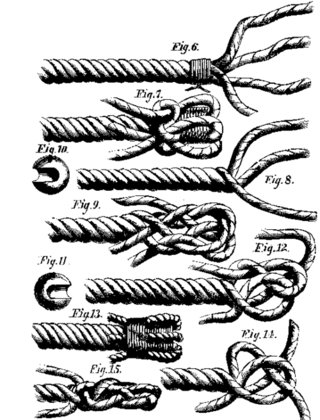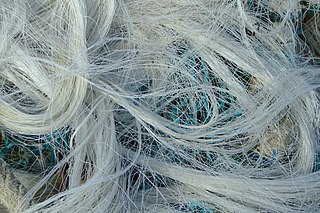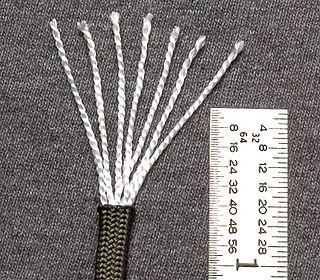Related Research Articles

A fishing line is a flexible, high-tensile cord used in angling to tether and pull in fish, in conjunction with at least one hook. Fishing lines are usually pulled by and stored in a reel, but can also be retrieved by hand, with a fixed attachment to the end of a rod, or via a motor.

Fly fishing is an angling technique that uses an ultralight-weight lure called an artificial fly, which typically mimics small invertebrates such as flying and aquatic insects to attract and catch fish. Because the mass of the fly lure is insufficient to overcome air resistance, it cannot be launched far using conventional gears and techniques, so specialized tackles are used instead and the casting techniques are significantly different from other forms of angling. It is also very common for the angler to wear waders, carry a hand net, and stand in the water when fishing.

A rope is a group of yarns, plies, fibres, or strands that are twisted or braided together into a larger and stronger form. Ropes have tensile strength and so can be used for dragging and lifting. Rope is thicker and stronger than similarly constructed cord, string, and twine.

A speargun is a ranged underwater fishing device designed to launch a tethered spear or harpoon to impale fish or other marine animals and targets. Spearguns are used in sport fishing and underwater target shooting. The two basic types are pneumatic and elastic. Spear types come in a number of varieties including threaded, break-away and lined. Floats and buoys are common accessories when targeting larger fish.

Rope splicing in ropework is the forming of a semi-permanent joint between two ropes or two parts of the same rope by partly untwisting and then interweaving their strands. Splices can be used to form a stopper at the end of a line, to form a loop or an eye in a rope, or for joining two ropes together. Splices are preferred to knotted rope, since while a knot typically reduces the strength by 20–40%, a splice is capable of attaining a rope's full strength. However, splicing usually results in a thickening of the line and, if subsequently removed, leaves a distortion of the rope. Most types of splices are used on three-strand rope, but some can be done on 12-strand or greater single-braided rope, as well as most double braids.

Monofilament fishing line is fishing line made from a single fiber of plastic material, as opposed to multifilament or braided fishing lines constructed from multiple strands of fibers. Most fishing lines are now nylon monofilament because they are cheap to produce and can be produced in a range of diameters which have different tensile strengths. Monofilament line is also manufactured in different colors, such as clear, white, green, blue, red, and fluorescent.

The Albright special or Albright knot is a bend used in angling. It is a strong knot used to tie two different diameters of line together, for instance to tie monofilament to braid. The Albright is relatively smooth and passes through guides when required. Some anglers coat the knot with a rubber based cement to make it even smoother and more secure.

Power Pro a type of braided fishing line made out of a material called Spectra fibers. It has an equivalent diameter of nearly 1/5 of monofilament. Thus the diameter of a piece of Power Pro testing at 50 pounds is equivalent to monofilaments' diameter testing at around 12 pounds. It lacks stretch that monofilament has, giving the fisherman a better "feel" and also helps set the hook faster. Environmentalists have criticized the use of spectra fiber, as it takes a long time to degrade thus harming the environment. Spectra is a form of gel-spun polyethylene.

Parachute cord is a lightweight nylon kernmantle rope originally used in the suspension lines of parachutes. This cord is now used as a general purpose utility cord. This versatile cord was used by astronauts during the 82nd Space Shuttle mission to repair the Hubble Space Telescope.

The eye splice is a method of creating a permanent loop in the end of a rope by means of rope splicing.

The nail knot, also known as the tube knot or gryp knot, is mostly used in carp and fly-fishing. The nail knot was named because a nail was inserted as a guide when threading the line. Today, it is easier to use a small straw. The nail knot is an important fishing knot used to join two lines of different diameters and allows for line diameters to diminish down to the fly. I.E., it is useful for attaching your backing to the fly line, and your fly line to the leader, or tippet. The knot can be tied in multiple ways and is uniform.

The improved clinch knot, also known as the Salmon Knot, is a knot that is used for securing a fishing line to the fishing lure, but can also affix fishing line to a swivel, clip, or artificial fly. This is a common knot used by anglers because of its simple tie and strong hold. When more pull is being applied, the harder the knot turns into itself, increasing the strength of the connection. It can be used with many kinds of line including mono-filament, fluorocarbon, and braided fishing line.

The Palomar knot is a knot that is used for securing a fishing line to a fishing lure, snap or swivel.

Fishing tackle is the equipment used by anglers when fishing. Almost any equipment or gear used in fishing can be called fishing tackle, examples being hooks, lines, baits/lures, rods, reels, floats, sinkers/feeders, nets, spears, gaffs and traps, as well as wires, snaps, beads, spoons, blades, spinners, clevises and tools that make it easy to tie knots.
Multifilament line, also referred to as The Super Lines, is a type of fishing line. It is a braided line which is made up of ultra-high-molecular-weight polyethylene (UHMWPE), a specialty polyethylene polymer that makes an extremely thin line for its strength. By weight, UHMWPE strands are five to ten times sturdier than steel. Multifilament line is similar to braided dacron in terms of sensitivity but a diameter about one-third that of the ubiquitous nylon monofilament line.

A surgical suture, also known as a stitch or stitches, is a medical device used to hold body tissues together and approximate wound edges after an injury or surgery. Application generally involves using a needle with an attached length of thread. There are numerous types of suture which differ by needle shape and size as well as thread material and characteristics. Selection of surgical suture should be determined by the characteristics and location of the wound or the specific body tissues being approximated.

In kiting, a line is the string or thin cord made of cotton, nylon, silk, or wire, which connects the kite to the person operating it or an anchor. Kites have a set of wings, a set of anchors, and a set of lines coupling the wings with the anchors. Kite lines perform various roles: bridle, control, tug, or special duty.
Fly fishing tackle comprises the fishing tackle or equipment typically used by fly anglers. Fly fishing tackle includes:

The uni knot is a multi-purpose fishing knot used in angling that can be used for attaching the fishing line to the spool of a reel, for joining main line to leader/backing lines, and for attaching lures, swivels and snaps.

Tenkara fishing is a type of simple rod angling traditionally practiced in Japan. Primarily used for mountain stream trout fishing, tenkara is still a fairly rare method even among freshwater anglers in Japan, and was largely unknown outside Japan until 2009, when the company Tenkara USA, founded by Daniel Galhardo, introduced and popularized tenkara outside Japan.
References
- ↑ McNally, Bob (3 August 2019), How to Pick the Right Kind of Fishing Line, Outdoor World (published August 2, 2019), archived from the original on 10 April 2021, retrieved 6 October 2019
- ↑ "Best Braided Fishing Lines". 7 September 2022. Archived from the original on 3 October 2022. Retrieved 5 February 2023.
- ↑ "BCF Content Hub - Blog - Braid Vs Mono - BCF Australia". Archived from the original on 2018-03-22. Retrieved 2018-03-22.
- ↑ "Braided Fishing Line". Fisherreel. Archived from the original on 2021-07-28. Retrieved 2019-08-21.
- ↑ "Best Fishing Stuff - Review of the Best Fishing Stuff on the Planet". Archived from the original on 2022-01-06. Retrieved 2021-12-14.
- ↑ "Types of Fishing Lines". Archived from the original on 2018-03-08. Retrieved 2018-03-07.
- ↑ "Archived copy". Archived from the original on 2017-09-14. Retrieved 2017-10-06.
{{cite web}}: CS1 maint: archived copy as title (link)

